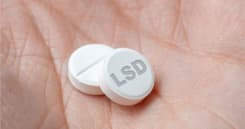Substance use disorder (SUD) is the clinical term for drug addiction. It is a progressive disorder characterized by compulsive drug abuse, persistent use regardless of consequences, relapse, and lasting changes in brain function. It is a complicated condition, considered both a mental illness and a brain disorder.
Substance use disorder is the final stage of the range of drug use and abuse. Most don’t start out with a substance use disorder right away. They begin with casual or recreational use, progress through increasingly severe stages of use, then finally developing substance use disorder.
If left untreated, substance use disorder can be fatal. Thankfully, substance abuse treatment is available and effective for those trying to quit using drugs. Continue reading to learn more about substance use disorder, including signs, causes, treatment options, and more.
Definition of Substance Use Disorder
Despite growing awareness surrounding drug addiction, many still don’t understand how people become addicted to drugs. False beliefs and myths about substance use disorder run rampant, including the idea that someone struggling with drug addiction can simply stop whenever they choose to.

Substance use disorder is a serious and complex condition where drug use has progressed past the point of recreational use. Drug addiction is far more consequential than casual use. It consists of compulsive use that’s hard to control, even in the face of mounting consequences. Though people choose to take drugs at first, those with substance use disorder at some point lost the power of choice.
Substance use disorder is also defined as a “relapsing” disorder, meaning individuals are at risk of returning to drugs after even decades of sobriety. Still, treatment provides a pathway to recovery that sets newly-sober individuals up for success. Reducing the ongoing risk of relapse requires ongoing action, through things like therapy or 12-step recovery meetings.
Types of Substance Use Disorders
There is only one type of substance use disorder but you can develop SUD involving many different types of drugs. Some drugs, like opioids or methamphetamine, are more addictive than others, like marijuana. Whatever drug is the target of use, though, puts the person at risk of developing serious short- and long-term health effects.
The National Survey on Drug Use and Health collects data every year regarding rates of drug use, abuse, and addiction in the United States. According to the NSDUH for 2019, the substances below have the following number of people with active substance use disorders for each:
- Alcohol: 14.5 million people
- Marijuana: 4.8 million people
- Opioids: 1.6 million people
- Prescription Painkillers: 1.4 million people
- Cocaine: 1 million people
- Methamphetamine: 1 million people
- Prescription Tranquilizers or Sedatives: 681,000 people
- Prescription Stimulants: 558,000 people
- Heroin: 438,000 people
The numbers do include some crossover between substances for those who combine their drugs of choice. A total of 8.3 million people in the U.S. ages 12 and older struggled with a substance use disorder to at least one type of drug in the last year alone.
Substance Use Disorder vs. Dependence
Some people confuse substance use disorder with substance dependence. These are two different things, though. While people with SUD also have substance dependence, not all people who are dependent also have a SUD.
Substance dependence means the person developed a physical or psychological dependence on a drug. This usually refers to people taking prescription medications for medical issues, like benzodiazepines or opioids. They rely on these drugs to function normally and experience severe reactions if they stop taking them suddenly.
Compulsive use is one of the main things that differentiate substance use disorder from dependence. People with substance dependence use their drugs because it’s necessary but not in a compulsive manner. Those with SUD use drugs compulsively and continue doing so even after negative consequences start adding up.
Substance Use Disorder vs. Addiction
Substance use disorder and addiction are the same things. Drug addiction is the term used more often when discussing people struggling with SUD. In clinical settings, addiction is referred to as substance use disorder. Addiction has also developed a negative connotation over time so some use SUD as a more considerate way of referring to the condition.

Methamphetamine is a strong illegal drug that causes a number of stimulating effects. It’s highly addictive with nearly a million active users each month. Plenty of misunderstanding surrounds the drug and its users, though. Learn more about methamphetamine and the impact it has on those who use it.
More info
Learn more about post-traumatic stress disorder, an intense, pervasive, complicated condition that some develop in response to experiencing a traumatic event.
More infoSubstance Use Disorder in the United States
Substance use disorder in the United States is a serious, ongoing problem. Many have a preconceived notion of what someone struggling with substance abuse “looks like.” In reality, there’s no one picture of what a person with substance use disorder looks like. Drugs and alcohol affect people all over the country from all walks of life.

Addiction does not discriminate. Anyone may develop a problem with substance abuse: young or old, rich or poor, male or female, white collar or blue collar, city dwelling or country living alike. Though some are more predisposed to addiction than others, there are still millions of others who never imagined they would have a problem.
An estimated 57.2 million people in the United States used illicit drugs in the past year. Not all of them cross the line from recreational or casual use into abuse or addiction, though. According to the National Survey on Drug Use and Health, 3 percent of the population ages 12 and older (8.3 million people) had at least one substance use disorder in the last year.
The study breaks down substance use disorder in the United States down into various categories as well. It looks at the types of drugs used, whether there’s a co-occurring mental health disorder, differences between adult and adolescent use, and more. How do substance use disorders in adults and in adolescents differ?
Substance Use Disorder in Adults
The NSDUH splits substance use disorder in adults into two categories: ages 18 to 25 and ages 26 and older. Understandably, substance abuse problems are most prevalent in the young adult population than in older adults.
4.9 million young adults and 4.9 million adults ages 26 and older reported having an illicit drug use disorder in 2019. Though the actual numbers of those with an SUD are similar, the percentages reveal the truth about use among each group. 7.5 percent of young adults struggle with drug addiction compared to 2.3 percent of adults ages 26 and older.
These statistics have remained relatively stable over the past five years. It’s relieving to note that the numbers haven’t increased but the problem is still far from over. There is still lots of work to do in regards to lowering the number of people battling substance use disorder.
Substance Use Disorder in Adolescents
Rates of substance use disorder in adolescents are lower than the young adult population but higher than adults ages 26 and older. 849,000 young people had an active substance use disorder in 2019. Again, even though the number itself is smaller, the percentage reveals the truth. Of the adolescents ages 12 to 17 in the U.S., 3.6 percent struggle with addiction.
These rates were lower in 2017 and 2018 than they were in 2015 or 2016. The decline offered some hope and felt like a promising sign but was unfortunately short-lived. Rates in 2019 were similar to those in 2015 and 2016, a disheartening finding. The numbers show there are still far too many
adolescents dealing with substance use disorder.
Substance Use Disorder and COVID-19
When the COVID-19 coronavirus pandemic broke out in early 2020, addiction experts worried about its effects on drug and alcohol use. They were concerned about both those with active substance use disorders as well as those in recovery.
The precautions taken to limit the spread of the virus, such as social distancing and stay-at-home orders, kept millions isolated and on their own. Isolation is the breeding ground for drug and alcohol abuse in those who deal with substance use disorders. Experts wondered how these measures would impact people struggling with addiction.
Though official numbers are still in the works, some results have surfaced over the last few months. The Overdose Detection Mapping Application program noted a 17.5 percent increase in suspected drug overdoses during the start of COVID-19 precautions. Another study from the National Emergency Medical Services Information System showed the overdose rates in May 2020 were more than 2 times higher than rates in previous years.
The predictions look daunting but they won’t be confirmed until more official research and studies are released. Ultimately, the relationship between substance use disorder and COVID-19 is grim. Increasing access to addiction treatment services and other resources is a vital part of the solution.
Causes of Substance Use Disorder
When someone develops a problem with their drug use, many wonder what are the causes of substance use disorder. If you can determine the cause of the problem then you should better be able to address and fix it, right? Some point to the person’s genetics, others point to their environment, and others only blame the drugs.

Unfortunately, substance use disorder isn’t that simple and straightforward. Current research suggests that there is a combination of causes of substance use disorder. The three main factors that play a role in whether someone becomes dependent on substances are biology, environment, and development.
Specific causes depend on each individual. Causes of substance use disorder are not an exact science and they vary on a case-by-case basis. Developing a substance use disorder does not mean someone is weak-willed or a bad person. Some people are simply more at risk of having problems with drug and alcohol use.
Is Substance Use Disorder a Disease?
Medical professionals consider substance use disorder a disease. It is classified as a chronic, relapsing condition. Substance use disorder is characterized by compulsive drug use despite consequences and long-term changes to the brain. Though taking drugs is a choice at first, over time people with the disorder lose the power of choice.
There is no real cure for addiction, much like other chronic diseases but recovery is possible. For many people, the only way to overcome substance use disorder is to stop using drugs entirely. Some may be able to control their use after some time but many find that abstinence is the most effective way of controlling their disease.
Is Substance Use Disorder in the DSM?
Substance use disorder is in the DSM, or the Diagnostic and Statistical Manual of Mental Disorders. This is the manual clinicians use to diagnose individuals with various mental health disorders, from anxiety and depression to substance use disorder.
The single substance use disorder diagnosis replaced the two prior categories of substance abuse and substance dependence in 2013. Now substance use disorder is broken down into three levels: mild, moderate, and severe. The severity of an individual’s substance use disorder depends on the number of criteria they meet.
- Mild: 2 to 3 symptoms
- Moderate: 4 to 5 symptoms
- Severe: 6 or more symptoms
The 11 possible criteria for substance use disorder include:
- Taking more of the substance or using it for longer than intended.
- Trying unsuccessfully to cut back or quit.
- Spending lots of time either getting or using substances, or recovering from their effects.
- Experiencing craving, or the strong urge to use substances.
- Failing to fulfill obligations at work, school, or home as a result
of substance use. - Continuing to use substances despite the consequences that occur.
- Cutting back on or giving up activities or social engagements to use substances.
- Ending up in dangerous situations as a result of substance use.
- Using the substance despite it making existing conditions worse, or
causing new ones. - Developing tolerance, or the need to take more to achieve the desired effect.
- Experience symptoms of withdrawal after not using the substance for
some time.

Is Substance Use Disorder Genetic?
When someone has a substance use disorder people often look to their parents to see whether they also had a problem. Most people assume that the main cause of substance use disorder is genetics. Genetics do play a role in the buildup of substance problems but they’re only partly responsible. Environment and development also play a role.
Some genetic factors leave certain people more predisposed to experiencing adverse reactions to alcohol and drugs. Things like gender, ethnicity, and the presence of other mental health disorders also have a part in whether someone develops substance use disorder.
Is Substance Use Disorder a Disability?
Substance use disorder qualifies as a disability under the Americans with Disabilities Act and the Affordable Care Act. To qualify as a disability, it must substantially limit a person’s major life activities. This provides some protection and keeps them from facing discrimination based on their problems with substance abuse.
Substance use disorder is also considered a disability if someone completes a drug rehabilitation program and is in recovery from addiction. It also protects those who are actively participating in an addiction treatment program and free from all substances.

Cocaine is a drug notorious for its place in the clubbing and nightlife scenes of major cities throughout the world. What exactly is cocaine, how is it made, where does it come from, and what does it do? Learn more about the impact of cocaine on the body, on society, and more.
More info
LSD, also called acid, is a popular hallucinogenic drug known for its psychedelic properties. Learn more about LSD, its effects, risks of use, and treatment option.
More infoSigns & Symptoms of Substance Use Disorder
There are many different signs and symptoms of substance use disorder to look for. Different drugs cause different reactions so some symptoms depend on the types of substances used. For example, opioids make the user tired, lethargic, and zoned out. On the other hand, stimulants make the user alert, awake, and restless.

You can learn more about the specifics for each type of drug but there are also some general signs and symptoms of substance use disorder you can keep an eye out for. If you’re concerned your loved one might have a problem with substances, they may exhibit some of the following symptoms and behaviors:
- Hostility when confronted about substance use
- Secretive behavior
- Unexplained absences or disappearances
- Decreased performance at work or school
- Missing work or school
- Making excuses to cover for their abnormal behavior
- Suddenly changing social groups
- Withdrawing from friends and family
- Neglecting basic needs such as personal hygiene
- Not eating enough
- Avoiding or quitting activities they used to enjoy
- Drastic mood swings
- Episodes of violence
These are just some of the many signs and symptoms of substance use disorder.
How is Substance Use Disorder Diagnosed?
Clinicians diagnose substance use disorder using the criteria from the DSM listed above. The 11 criteria outline the most common and severe symptoms seen in someone with substance use disorder. If a person comes in concerned about their drug use, or a clinician notices the signs of drug use even without their mentioning it, they’ll look to the DSM.

Substance use disorder diagnoses are separated into three categories: mild, moderate, and severe. Someone who meets 2 or 3 of the criteria is diagnosed with a mild condition. Those who exhibit 4 or 5 of the criteria have a moderate use disorder. Anyone experiencing 6 or more criteria is diagnosed with a severe substance use disorder.
People with mild and moderate disorders may have an easier time getting sober than those with severe conditions. Still, overcoming substance use disorder in any capacity is not an easy thing to do. Thankfully, treatment for substance use disorder is available at specialized addiction treatment facilities.
How to Treat Substance Use Disorder
Though there is no cure for the condition, there are ways to treat substance use disorder. Someone with a mid or even moderate disorder may be able to stop without outside help. It’s better to seek input from a medical professional before deciding to stop using drugs, though. People with severe dependence issues may experience physical and psychological reactions if they stop using suddenly.

There are a few different levels of care available to treat substance use disorder depending on your needs. Addiction treatment is not a one-size-fits-all approach. Every person should be treated as an individual with consideration given to their particular needs. The levels
of treatment offer options for anyone seeking help.
Substance use disorder treatment usually consists of a 30-, 60-, or 90-day program. Treating substance use disorder involves a combination of individual counseling, group therapy, alternative treatment modalities, activities, and more. Some facilities use medication-assisted treatment when necessary, too.
Where to Get Help for Substance Use Disorder
Substance use disorder is a difficult condition to overcome. The problem doesn’t disappear once you stop using substances. Quitting drug use is only the start of the treatment process. Substance use disorder is a chronic, complex disease that requires ongoing and sometimes repeated care to maintain recovery.

Thankfully there are places to get help for substance use disorder. Some people find that recovery support groups like 12 step programs or other alternatives are sufficient for achieving recovery. Many times people need additional support before measures like recovery meetings can be effective. Substance use disorder treatment centers are the most common way people first make their way into recovery.
Substance Use Disorder Treatment Centers
Most people begin the journey into recovery at substance use disorder treatment centers. These facilities specialize in treating alcohol and drug addiction and some offer treatment for dual diagnosis disorders as well. They provide a place for people to safely separate from all substances and lay the foundation for living clean and sober.
Addiction treatment facilities understand that there is no single “one-size-fits-all” path to recovery. The most effective approach to treatment considers each individual’s needs on a case-by-case basis. Because of this, many facilities offer different levels of care to help the widest range of people possible.
These levels of care at substance use disorder treatment centers include:
Some people need a comprehensive program that starts with medically-supervised detox then proceeds through each level of treatment. Others find that starting with outpatient rehab works for their situation. This is why each person needs an individualized program suited for their particular needs.
What do the different levels of care consist of?
Substance Use Disorder Inpatient Treatment
Inpatient treatment is a residential treatment option that offers full-time care. Inpatient treatment often starts with a short-term medical detox. Treatment cannot be effective until drugs are completely cleared from the person’s system.
Detox consists of separating new clients from all substances and overseeing them during the drug withdrawal process. Depending on the type or types of substances used, detox typically takes a few days to a week. Those who use harder substances, such as heroin, will have a more severe and longer detox period.
After all the substances are cleared from their system, the client moves into the next phase of treatment. Inpatient addiction treatment consists of programs during the day and houses clients in the evenings. Daytime programming includes individual therapy, group therapy, holistic treatment modalities, activities, and more. Specific types of therapy and other activities depend on the treatment facility.
Most inpatient treatment programs take place over 30-, 60-, or 90-day periods depending on the individual’s needs. People with more severe substance use disorders tend to opt for longer programs which allows them to build a stronger foundation of recovery before moving into outpatient care.
Substance Use Disorder Outpatient Treatment
Outpatient treatment for substance use disorder offers the same quality care but allows clients to live off-site outside of program hours. Some people attend outpatient as a follow-up to their stay in an inpatient treatment program. Others select outpatient treatment because it allows for flexibility in terms of living arrangements and scheduling.
Outpatient programs typically meet for 3 to 5 hours of programming per day, 3 days per week. This allows individuals with responsibilities that keep them from attending a full-time program to still receive the help they need. It also serves as a transition period from full-time care back into the real world for those who attend after inpatient treatment.
The length of an outpatient treatment program for substance use disorder depends on the client’s needs. It offers support and guidance to newly clean and sober individuals as they reintegrate into their lives.
How Substance Abuse Could Be Prevented
The one true way to make sure substance abuse could be prevented is to avoid using drugs in the first place. There’s the common argument that people with substance use disorder are responsible for their problem because they made the initial choice to use drugs. While there is some truth to that statement, oftentimes substance abuse isn’t that simple or straightforward.

Many people with substance use disorders started using drugs during their adolescent years. Early drug use significantly increases a person’s chance of developing a substance use disorder. Drugs alter the brain chemistry of fully-developed adults; their effects on an adolescent’s developing brain are even more impactful.
Adolescents experiment with substances for many different reasons. There’s the developmental aspect of curiosity and risk-taking, a drive to try new things, as well as an urge to find a sense of independence. These features of adolescence lead to their tendencies to try things like alcohol and drugs. School campaigns and programs that raise awareness about the risks and dangers of substance use are often helpful and produce positive results.
Additionally, the risk of drug use in both adolescents and adults increases during times of transition. Adults are more likely to turn to drugs during events like job loss or divorce. Teenagers find solace in substances during experiences like parental divorce, changing schools, or peer pressure.
Listening and providing support during these times of change is crucial. Being aware of the risks associated with these events is important. Keep an eye out for signs of drug addiction and be ready to offer kind and loving help if they seem in need of it. Doing what you can to ensure substance abuse could be prevented in your loved one can make a world of difference.
If you have a loved one who’s struggling with substance use, Hawaii Island Recovery can help. With a state-of-the-art facility located on the big island of Hawaii, Hawaii Island Recovery uses a comprehensive, compassionate approach to addiction treatment.To learn more, reach out to us to speak with an admissions specialist today!
Overcome Drug Addiction
If you or a loved one need help, call Hawaii Island Recovery toll-free right now.
866-390-5070 Hawaii Island Recovery
Hawaii Island Recovery 










